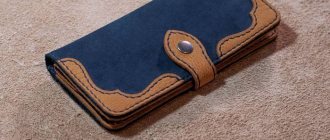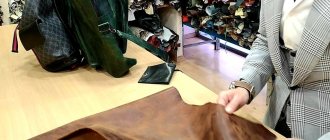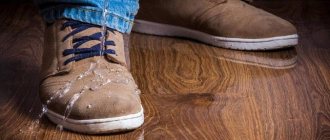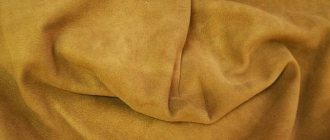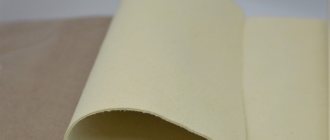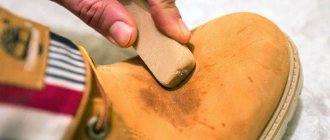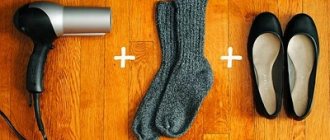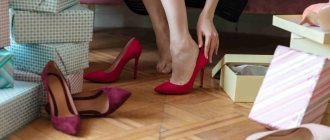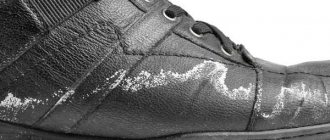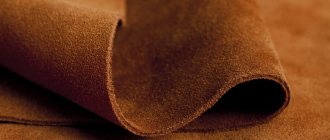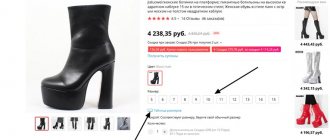Nubuck shoes - pros, cons and is it worth buying?
Nubuck shoes appeared on the market relatively recently. This material has gained great popularity among both girls and boys. The main advantage is appearance . Even the most homely couple looks attractive. Manufacturers create a wide selection: from summer shoes to winter boots with thick soles. In terms of strength, nubuck is not inferior to expensive analogues. If you choose boots or shoes made from it, you need to know several rules for their care, since the material is demanding in this regard.
Manufacturing, care and wear
Nubuck is produced by finely sanding the leather on the grain side. After the procedure, a lot of villi appear. There are 2 types of products:
- Natural (cattle leather is used).
- Artificial (only synthetic raw materials are used, sometimes the type is classified as a type of flock).
It is known that nubuck is very fastidious in care . Boots may develop stains after just one trip outside. In summer, dust settles on shoes, which spoils their appearance. This especially worries girls, since they choose the material because of its beauty and nobility.
The pair should be cleaned with a soft, dry sponge or brush. If your boots have complex dirt, it is recommended to purchase a special spray that can easily deal with the problem.
Features and types of material
The technology for making nubuck is quite new and involves mechanical grinding of animal skin with fine-grained abrasives. Raw materials processed in this way acquire a velvety appearance. In addition, the skin becomes durable, capable of withstanding significant mechanical load. The material quickly gained popularity, becoming a worthy competitor to expensive leather. Against the backdrop of its widespread use, the questions of how to care for nubuck and how long such shoes last have become relevant. To find the right answers, you need to compare the features of the natural materials used to make shoes.
| Features and Properties | Leather | Suede | Nubuck |
| What are they made from? | Mainly taken from cattle skin | Made from small animal skins | From cattle hides |
| Strength, wear resistance | Durable, lasts a long time, but over time creases form, which give the shoes a worn look. | Elastic, but thin, afraid of moisture, and if not properly cared for, quickly loses its appearance | More durable than suede and has good thermal insulation |
| Water resistance | Waterproof, when choosing winter shoes, this material is most often chosen | Easily gets wet and stretches, so it is used mainly in dry weather | More resistant to moisture than suede, but still absorbs it, losing its attractive appearance, so is more suitable for dry weather |
| Breathability | Does not create a greenhouse effect, absorbs excess moisture from the inside | Ensures normal air circulation, retaining heat | Denser than suede, but generally more hygroscopic, breathable material |
| Appearance and care | Looks solid, easily acquires a neat appearance with the help of special creams | It looks soft and velvety, wears off over time, and then begins to shine. Needs protection from moisture and regular maintenance | It looks velvety; when wet and then dried, it can become covered with white streaks. Needs special care products for nubuck shoes |
Shoes made of nubuck look original due to their high velvety feel, while the material is quite dense. Unlike leather and suede products, it has a light structure, which means there is less stress on the feet. Products made from these raw materials last longer, are more reliable and durable. Commercially available impregnation for nubuck allows you to protect shoes from moisture without losing their appearance. It is not surprising that manufacturers are constantly expanding their new collections with models made from practical raw materials and experimenting with its varieties.
One of the variations of the natural material is nubuck-oil or oiled nubuck, which is impregnated with water-repellent protective agents during the manufacturing process. It is heavier than usual, but is suitable for winter and autumn shoes, when rain and slush can very quickly give way to dry weather. It is easier to care for impregnated nubuck than regular nubuck.
By analogy with natural material, a substitute was developed that is almost impossible to distinguish by appearance. Artificial nubuck is more moisture resistant, but at the same time denser. Despite its attractive appearance, it does not absorb moisture well from the inside, and accordingly, the foot sweats more.
Nubuck-oilTo know for sure whether the shoes are made from natural or artificial nubuck, you should pay attention to the label that is present on the boots of global manufacturers. Natural material is accompanied by a pictogram of stretched skin, while artificial material is usually marked with a diamond.
Artificial nubuck
Advantages
The products look elegant and presentable. Nubuck has many advantages over other types of materials:
- Gives the shoes nobility and sophistication , even if the pair looks plain (summer ballet flats look good with an evening dress).
- Suitable for both everyday wear and evening outing.
- It is a “breathable” product , thanks to the sanding treatment, the foot does not sweat, there is no unpleasant odor after prolonged wear (this applies to products made from natural materials) - this distinguishes it from natural leather.
- Compared to other products, it is more affordable .
- With proper care, it can last several seasons (2-3) and is highly durable.
- The stores have a wide selection of shoes, from light summer ballet flats to winter boots.
- Easy to paint , which allows you to choose any color scheme, and creative people who are interested in design can do this at home.
- It retains heat well and is easy to wear in summer ; your legs do not get tired after a long walk, unlike other materials.
- It is possible to purchase a model with ready-made treatment against dirt and moisture.
Buyers also have a choice: a natural or synthetic product. There is no big difference between them, except for breathability. Synthetics are poorly breathable, which can have a detrimental effect on the health of your feet.
Material characteristics
Regardless of whether we are talking about artificial or natural nubuck, reviews of products made from it are positive.
It is believed that the man-made analogue is more affordable and more practical to use. Outwardly, it looks almost like suede, only denser. Made from polymer raw materials that do not allow water to pass through. If you don't know how to distinguish natural nubuck from synthetics, pay attention to absorbency. If natural leather gets wet, even if a little, then man-made leather does not. Plus, such shoes practically do not allow air to pass through, and sometimes the foot becomes uncomfortable in them.
To understand and imagine exactly what kind of material this is - artificial nubuck, let's turn to the history of its creation.
Many “advisers” on the Internet confuse nubuck with suede, velor, genuine leather and even fabric. Let's conduct a short educational program on what nubuck is and how it differs from other materials, what types exist. Often people are looking for an answer to the question of whether it is leather or not.
There have long been several methods of tanning leather. This is done using fat, salt, extracts of certain types of trees (for example, oak), sand and other materials. The main difference between nubuck and suede is the material and tanning method. Suede is made from the skin of small cattle, and nubuck is made from large cattle (deer, elk, yaks). Tanning of suede is carried out using fat and fat-formaldehyde compounds. Nubuck is tanned with mineral salts, most often chrome.
Leather treated in this way is more pliable and wear-resistant. Shoes and furniture upholstery made of nubuck offer excellent resistance to stretching and impact loads.
The main advantage of natural nubuck is the aesthetic and tactile pleasure from contact with it. Lying down on a sofa upholstered in natural nubuck is like touching something soft and tender! And shoes made from it look great in any situation and with any style.
Where is it used?
This material has two directions:
- Furniture. Upholstered furniture fabric is used to cover designer furniture, creating surfaces of chairs, armchairs, sofas and beds that are pleasant to the touch and to the eye.
- Shoe. The material protects our feet from overheating, hypothermia, and moisture.
Nubuck is a very beautiful material for shoes, women's boots and designer shoes.
In footwear, natural oiled nubuck is more common, as it has water-repellent properties. A natural analogue is better suited for furniture production - it is more pleasant to the touch.
Intolerance to high humidity
The packaging of many models contains information about water-repellent properties. However, this is not entirely true. The structure, without special treatment, quickly collapses and the shape of the product changes. Therefore, these models require regular treatment with a water-repellent spray. This is especially true for products intended to be worn in autumn and winter. For the same reason, you cannot clean shoes under water; only dry treatment is suitable, but it takes a lot of time and is not always effective (marks and stains remain). However, now there are already processed models on the market. This information needs to be clarified with the store clerks.
Expensive and time-consuming care
Nubuck is a very easily soiled material . Sometimes you have to clean your shoes after going outside once. The owner of the model will have to spend a lot of money to maintain the shoes in a presentable form. For such material you need a spray, cream, and a soft sponge (a hard one can ruin the appearance). Not everyone is able to spend a lot of money on care.
Impracticality
This material is unlikely to be suitable for daily walks. It gets dirty quickly , and some contaminants are deeply absorbed into the structure so that they cannot be removed, or you will have to take the boots to a professional company, which can be expensive. The color also fades over time. The reason for this is regular cleaning. The fibers deteriorate, making the appearance of the model less beautiful. The best solution would be to choose products for evening meetings or holidays. Nubuck is not a suitable material for those who like practical shoes and daily walks.
How to care for nubuck shoes
So, it was noted above that this is quite capricious material. Accordingly, caring for it will not be easy. Therefore, immediately when buying a pair of shoes, you should purchase all the necessary supplies. The most important thing is to do the first cleaning immediately upon returning home with the purchase. The shoes are wiped down and a water-repellent compound is applied to them. This will allow you to extend the life of your boots, so do not neglect this action. After the first treatment, it is important to maintain constant care, otherwise these efforts will not be worth it. Give special care to your boots in rainy or snowy weather. Here are some cleaning tips:
- Dirt from the surface can be removed with a special stiff brush. If it has insufficient rigidity, then the dirt will not go away, and the material will no longer be velvety. In this case, you can only use a dry brush. If you don't have a brush at hand, you can use an eraser.
- If you want to wipe the outside with a damp sponge, you must use a special detergent. It will not spoil the material and prevent its deformation. At home, instead of a cleaning agent, you can take a solution of ammonia and water (1/4 ratio).
- If your nubuck shoes have stubborn stains or scuffs, spray paint can help. Carefully spray it onto the damaged area according to the instructions on the can.
- After the shoes are cleaned, you need to cover them with a special water-repellent impregnation (find out which is better here). This will create a protective layer and thereby make it easier to care for and prolong the durability of the material. The material must be treated with impregnation three times: each new layer is applied after the previous one has completely dried.
I also suggest you watch a video on the topic.
Thus, nubuck shoes are expensive materials and require care, but if you follow simple recommendations, they will last you more than one season.
